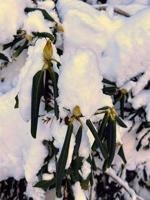Understanding winter damage in plants
By Julie Banken
WSU Chelan/Douglas County Master Gardener


Hardiness, as gardeners define it, is a plant’s ability to withstand cold temperatures. Leave a poinsettia outside overnight in Eastern Washington at this time of year and it will be obvious that it is not a cold-hardy plant.
What is it about some plants that makes them so sensitive to the cold, while other plants can spend an entire winter in freezing weather and be just fine?
Anyone with an underground sprinkler system knows what can happen if you don’t blow the water out of your irrigation pipes in the fall. Water that remains in your system can freeze solid when the temperature drops. As water freezes, it expands, and can crack the pipes. The damage becomes apparent in spring when the water is turned back on.
In the same way, plants with a lot of water in their vascular systems can suffer when they are exposed to freezing temperatures. Push a lettuce leaf too close to the back of the refrigerator and you will see the damage freezing temperatures can do to plant leaves. As much as 96% of a crisp lettuce leaf is water. When it freezes, water inside its leaf tissues expands, causing cell walls in the leaf to burst and turning the lettuce to slime.
To prevent their vascular pipes from bursting, at the onset of winter, cold-hardy plants are able to “harden off” by gradually decreasing the amount of water in their system. They direct water from their leaves and stems to their roots. Many plants shed their leaves altogether.
Unlike with a sprinkler system, cold-hardy plants can’t get rid of their water entirely, however. To prevent winter injury, they make it harder to freeze the water that remains in their system. As plants acclimate to the changing of the seasons, water in their stems and leaves becomes a more concentrated sugar solution which freezes at a lower temperature. In addition, just as people add ethylene glycol into their vehicles’ radiators, cold-tolerant plants can build up antifreeze proteins in their tissues to prevent ice from forming in and around their cells.
The physiological changes necessary for a plant to survive the winter take time. Shorter days and cooler nights trigger the acclimation process in early fall. By the time temperatures stay below freezing for an extended period, plants should be ready and waiting for winter in a state of dormancy.
Gardeners across North Central Washington right now are surely asking themselves this question: did plants have enough time to harden off this year? Last fall, the first frost didn’t occur until the end of October, and unseasonably warm temperatures persisted through December. Then out of the blue, the mercury in the thermometer fell to the negative numbers in January and stayed there for a week. Thankfully, a blanket of snow fell at the same time that temperatures plummeted, providing plants with at least a small layer of protection.
The coming of spring will begin to reveal the extent of this winter’s toll.
With some plants, frost damage can take months to appear. When water starts to flow through them again, living tissue will begin to grow while frost-bitten parts will not resprout. Gently scraping the bark off the stem of a woody plant will reveal either living or dead tissue beneath. Other signs of frost damage include shriveled, black, brown, or discolored leaves, split stems and dead buds.
This spring, when new growth (or the lack of it) indicates winter’s damage, wait patiently to take action. Don’t remove dead plant parts immediately. It is better to let dead leaves, stems and branches remain on the plant until the last chance of a late frost has passed. Even though it is dead, this material is insulating, and removing it too soon may expose your plant to even more freezing.
Also, take care not to encourage new growth too early in the springtime. Tender, new shoots have the most water in them and are the most susceptible to freezing if winter makes one last attack. To be safe, don’t prune or fertilize early.
If a human loses toes to frostbite, they will have to learn to walk without them. Fortunately for cold-hardy plants, if they lose stems or buds to frostbite, they can grow new ones. Fruit or flowers may be lost for a season, but in general, if their root system is intact and injury isn’t too severe, damage to the rest of the plant is superficial. Recovery just requires time.
A WSU Chelan and Douglas County Master Gardener column appears weekly in The Wenatchee World. To learn more, visit bit.ly/MGchelandouglas or call (509) 667-6540.
